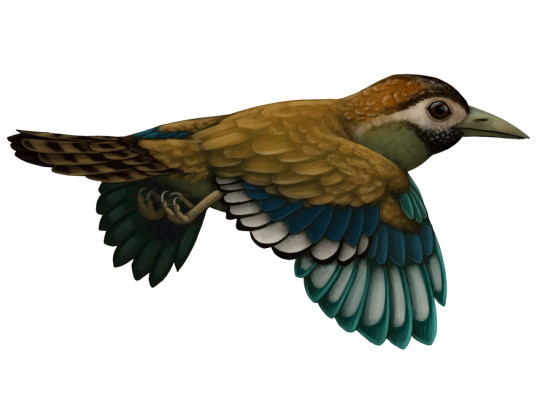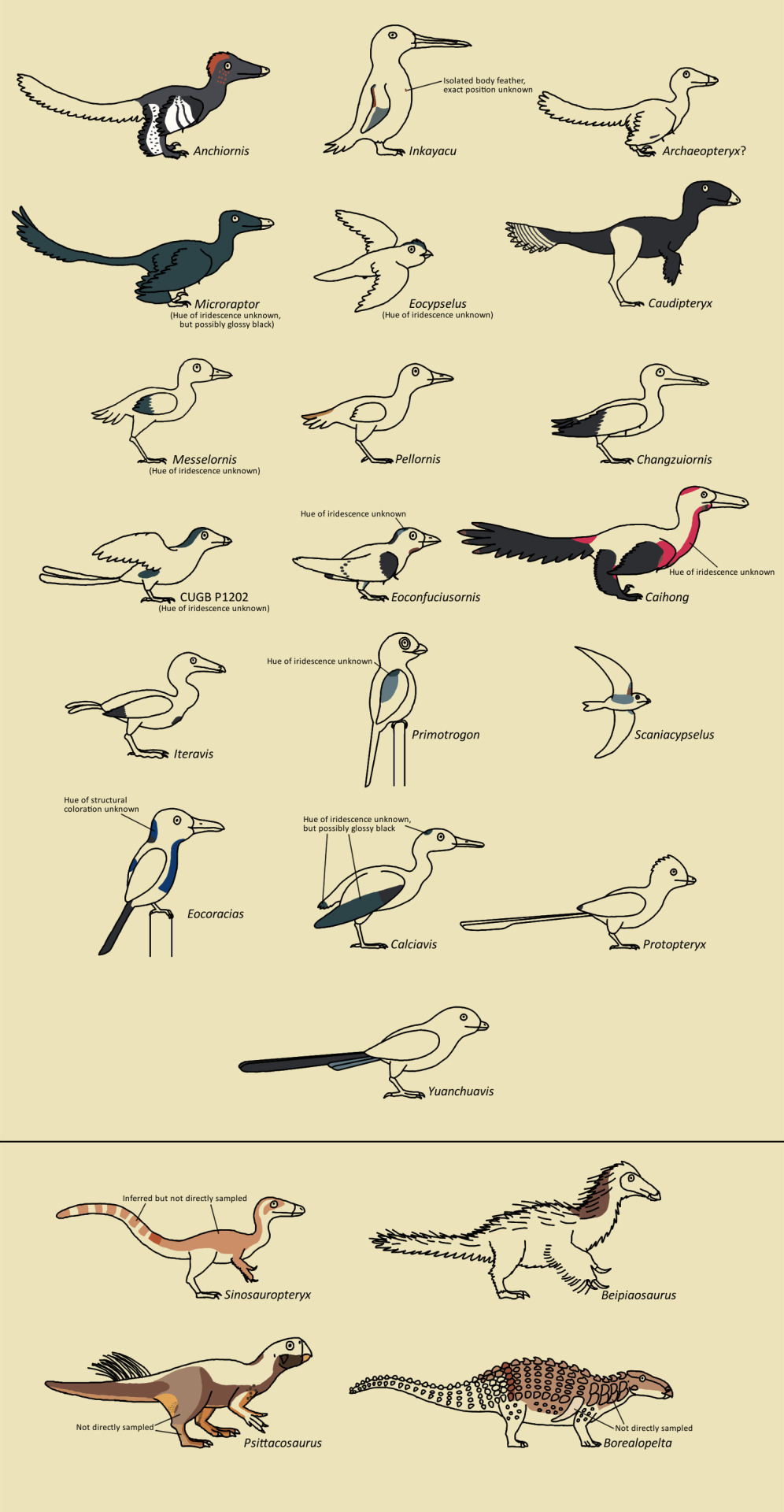#Scaniacypselus
Text
Fossil Novembirb: Day 11 - A New Dawn

Messel lake is a legendary fossil site from the middle Eocene of Germany, about 40 million years ago. It preserves incredible fossils and a great diversity of life thanks to the lake's dark, volcanic secrets. This was also famously the setting of the first episode of the paleodocumentary series Walking With Beasts. While the episode isn't particularly accurate and actually takes place at the later part of the Paleogene greenhouse, one thing is certain. There were a lot of birds here.
Hassiavis: An insectivorous bird related to nightjars and owlet-nightjars. The fossil of this bird is so well preserved that even the pattern of the bird's wing feathers is visible.
Paraprefica: An early relative of those peculiar South American birds, the potoos. In all likelyhood, this early potoo was just as weird as modern ones.
Scaniacypselus: One of the first true swifts, and was just as incredibly adapter for a life on the wing as modern swifts and tree-swifts.
Messelirrisor: A tiny insectivorous bird that was related to hoopoes.
Selmes: This small omnivorous bird was related to modern mousebirds. And like them, it could wwist all four of its toes forwards.
Eocoracias: A relative of rollers and the dollarbird that ate insects. The coloration of this bird is fully known thanks to excellent fossil preservation.
Masillastega: The earliest known gannet known from a complete skull. This booby dove under the surface to catch fish, though it likely didn't plunge down like modern boobies.
Rhynchaeites: A widespread wader known from multiple fossil sites in Europe. It closely resembles and may have been related to modern ibises.
Messelornis: A relative of modern rails and the obscure finfoots, this was a very successful bird, with fossils found from Europe and North America.
Juncitarsus: A long legged and spear beaked bird that resembles a crane, but is actually related to grebes and flamingoes. It used it's sharp beak to spear fish.
Paleotis: A relatively large and flightless relative of the modern ostriches, standing around a metre tall.
#Fossil Novembirb#Novembirb#Dinovember#birblr#palaeoblr#Birds#Dinosaurs#Cenozoic Birds#Hassiavis#Paraprefica#Scaniacypselus#Messelirrisor#Selmes#Eocoracias#Masillastega#Rhynchaeites#Messelornis#Juncitarsus#Paleotis
60 notes
·
View notes
Text
Fossil Novembirb 11: A New Dawn

Palaeotis by @drawingwithdinosaurs
One of the absolutely best known ecosystems of the Eocene is found at the Messel Pit site of Germany. Deposited in a similar way (via multiple volcanic eruptions over periods of thousands of years) to the Fossil Lake of yesterday, but a few million years later, it shows the end of the early Eocene and the start of the emergence of modern mammalian groups. Lucky for us, it also shows the next stage of bird evolution! This was also the site featured in the first episode of Walking With Beasts, "A New Dawn", though the avifauna was not particularly well represented in that program.
Yes, obviously, Gastornis was in Messel, though as a large ground herbivore than a predator. But there were plenty more birds than that! Lithornis was also here, because it was just as ubiquitous; and there was also the mysterious Palaeoganth Palaeotis. Originally thought to be a relative of Ostriches, then not, and now possibly again, this bird has a strangely intermediate morphology between that of large flightless Palaeognaths and the Lithornithids of the early Paleogene; indicating it may be a transitional form. It would not have been able to fly, given its short wings and lack of keel, and probably fed on small animals in its environment.

Juncitarsus by @thewoodparable
In addition to the Megafowl Gastornis, there was also the early landfowl Paraortygoides, which did not have a crop like living landfowl and as such probably mainly fed on soft plant material. It also had shorter legs than other landfowl relatives at the time, indicating it may have been more similar to living pheasants than fowl that had been around previously.
Even though the Flamingo-Ducks like Presbyornis would stick around well into the Neogene, the first relatives of Flamingos show up at around this time. Juncitarsus was a wading bird, probably just as closely related to living grebes as their cousins flamingos, and had gastroliths in its stomach - allowing it to feed on hard animals it gathered in from the lake. It wasn't the only wader; Messelornis, a wader related to living rails and cranes; is the most common bird at the Messel Pit and was an important generalist in its ecosystem. In addition, the "Snipe-Rail" Rhynchaeites was actually an ibis relative, probing for food with its beak in the substrate around the lake.

Scaniacypselus by Paleo Miguel
Strisores are everywhere at Messel, with relatives of swifts and hummingbirds like Cypseloramphus, Parargornis, and Scaniacypselus, which weren't as adapted to specialized aerial niches as their living relatives. An insectivore with tiny feet, Protocypselomorphus, was also present; as were an early potoo in the form of Paraprefica and an early frogmouth in the form of Masillapodargus.
Strange flight specialists far away from their living ranges aren't the only bizarre features of the ecosystem - Masillastega, a piscivore and relative of living gannets and boobies, was also present at Messel. More relatives of seriemas, like Dynamopterus, Salmila, and Strigogyps showcase how not all Cariamiformes were predators - Strigogyps was an herbivore! The long-legged predator Masillaraptor was present there too, indicating falcons were successful as multiple types of raptors prior to today. The owl Palaeoglaux was a small predatory bird, with ribbon-like feathers in dense layers on its back.

Eocoracias by @drawingwithdinosaurs
There were, of course, many tree dwelling birds in this lacustrine forest, including relatives from both sides of the "core landbirds" family tree. The ecosystem preserves a truly alarming number of mousebirds, including Chascacocolius with a conical beak, and Eoglaucidium with a strangely short tail. Eocoracias, another early roller like those found in Denmark, had iridescent feathers. Early hoopoes like Messelirrisor and early trogons like Masillatrogon show even more examples of more tropical birds showing up in higher latitude locations during this warm period. Messelastur was another possible Parrot/Passerine of prey; as was possibly Pumiliornis. Tons of pre-Passerines were here, too, including the zygodactly-footed Serudaptus, Psittacopes, and Primozygodactylus.
These dinosaurs were living at the end of a time of rapid evolution and diversification for most living things on Earth. However, the hot and humid times never last - as the planet begins to cool, drier ecosystems spread around the planet, and the global tropical forests fade into obscurity. It's time for these new groups of dinosaurs to adapt for new ecosystems...
Sources:
Mayr, 2022. Paleogene Fossil Birds, 2nd Edition. Springer Cham.
Mayr, 2017. Avian Evolution: The Fossil Record of Birds and its Paleobiological Significance (TOPA Topics in Paleobiology). Wiley Blackwell.
Smith, K. T. 2021. The Messel Pit: Window into a Greenhouse World. Geoconservation Research 4(2): 547-556.
118 notes
·
View notes
Photo

In the wake of 2021, added Yuanchuavis and modified Eoconfuciusornis for the paleocolor chart.
More detailed description
#Palaeoblr#Birblr#Dinosaurs#Birds#Feathered dinosaurs#Anchiornis#Inkayacu#Archaeopteryx#Microraptor#Eocypselus#Caudipteryx#Messelornis#Pellornis#Changzuiornis#Eoconfuciusornis#Caihong#Iteravis#Primotrogon#Scaniacypselus#Eocoracias#Calciavis#Protopteryx#Yuanchuavis#Sinosauropteryx#Beipiaosaurus#Psittacosaurus#Borealopelta
668 notes
·
View notes
Photo

Updated my dinosaur paleocolor lineup with a few new entries from 2020: the lithornithid Calciavis (glossy black plumage) and the enantiornithean Protopteryx (black wingtips).
More detailed description
#Palaeoblr#Birblr#Dinosaurs#Birds#Feathered dinosaurs#Anchiornis#Inkayacu#Archaeopteryx#Microraptor#Eocypselus#Caudipteryx#Messelornis#Pellornis#Changzuiornis#Eoconfuciusornis#Caihong#Iteravis#Primotrogon#Scaniacypselus#Eocoracias#Calciavis#Protopteryx#Sinosauropteryx#Beipiaosaurus#Psittacosaurus#Borealopelta
79 notes
·
View notes
Photo

The latest in dinosaur paleocolor! 2019 gave us the colors of Eocoracias, and Pellornis gets retroactively added after a previously unnamed specimen was assigned to it.
More detailed description
#Dinosaurs#Birds#Palaeoblr#Birblr#Feathered dinosaurs#Anchiornis#Inkayacu#Archaeopteryx#Microraptor#Eocypselus#Caudipteryx#Messelornis#Pellornis#Changzuiornis#Eoconfuciusornis#Caihong#Iteravis#Primotrogon#Scaniacypselus#Eocoracias#Sinosauropteryx#Beipiaosaurus#Psittacosaurus#Borealopelta
46 notes
·
View notes
Photo

2018 was a good year for the study of paleo-color, adding four species to the line-up of fossil dinosaurs with inferred coloration!
#Dinosaurs#Palaeoblr#Birds#Birblr#Feathered dinosaurs#Anchiornis#Inkayacu#Archaeopteryx#Microraptor#Eocypselus#Caudipteryx#Messelornis#Changzuiornis#Eoconfuciusornis#Caihong#Iteravis#Primotrogon#Scaniacypselus#Sinosauropteryx#Beipiaosaurus#Psittacosaurus#Borealopelta
816 notes
·
View notes
Photo

A recent study looked at the plumage coloration of Scaniacypselus, so time to update my drawing of Eocene swift and nightjar relatives.
#Palaeoblr#Birds#Dinosaurs#Hummingbirds#Potoos#Swifts#Oilbirds#Frogmouths#Strisorians#Prefica#Paraprefica#Fluvioviridavis#Eocypselus#Scaniacypselus#Parargornis
16 notes
·
View notes